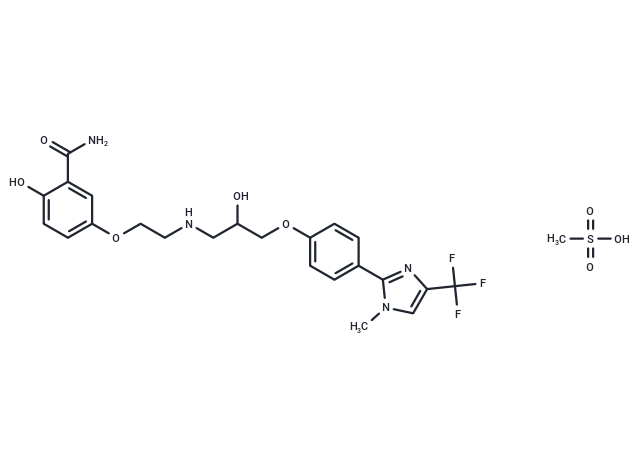Shopping Cart
- Remove All
 Your shopping cart is currently empty
Your shopping cart is currently empty

CGP 20712 A (CGP 20712 mesylate) is a selective and potent β1-adrenergic receptor antagonist (IC50: 0.7 nM) with antihypertensive activity, capable of reversing RKT-induced gastric relaxation.

| Pack Size | Price | Availability | Quantity |
|---|---|---|---|
| 1 mg | $98 | In Stock | |
| 5 mg | $289 | In Stock | |
| 10 mg | $428 | In Stock | |
| 25 mg | $698 | In Stock | |
| 50 mg | $968 | In Stock | |
| 100 mg | $1,280 | In Stock | |
| 200 mg | $1,760 | In Stock |
| Description | CGP 20712 A (CGP 20712 mesylate) is a selective and potent β1-adrenergic receptor antagonist (IC50: 0.7 nM) with antihypertensive activity, capable of reversing RKT-induced gastric relaxation. |
| Targets&IC50 | β1-adrenoceptor:0.7 nM, β1-adrenoceptor:0.7 nM |
| In vitro | In myocyte, saturation experiments conducted in the presence of 300nM CGP 20712A failed to detect specific binding of [125I]-ICYP and [3H]-CGP 12177[2]. |
| In vivo | Pre-treatment with 5mg/kg CGP 20712A (selective β1-adrenoceptor antagonist) in 8-day-old rats did not alter the plasma ACTH response to insulin injection[3]. |
| Alias | CGP 20712 mesylate |
| Molecular Weight | 590.57 |
| Formula | C24H29F3N4O8S |
| Cas No. | 105737-62-0 |
| Smiles | O=C(N)C1=CC(OCCNCC(O)COC=2C=CC(=CC2)C3=NC(=CN3C)C(F)(F)F)=CC=C1O.O=S(=O)(O)C |
| Relative Density. | no data available |
| Storage | keep away from moisture | Powder: -20°C for 3 years | In solvent: -80°C for 1 year | Shipping with blue ice/Shipping at ambient temperature. | |||||||||||||||||||||||||||||||||||
| Solubility Information | DMSO: 80 mg/mL (135.46 mM), Sonification is recommended. | |||||||||||||||||||||||||||||||||||
Solution Preparation Table | ||||||||||||||||||||||||||||||||||||
DMSO
| ||||||||||||||||||||||||||||||||||||

Copyright © 2015-2025 TargetMol Chemicals Inc. All Rights Reserved.